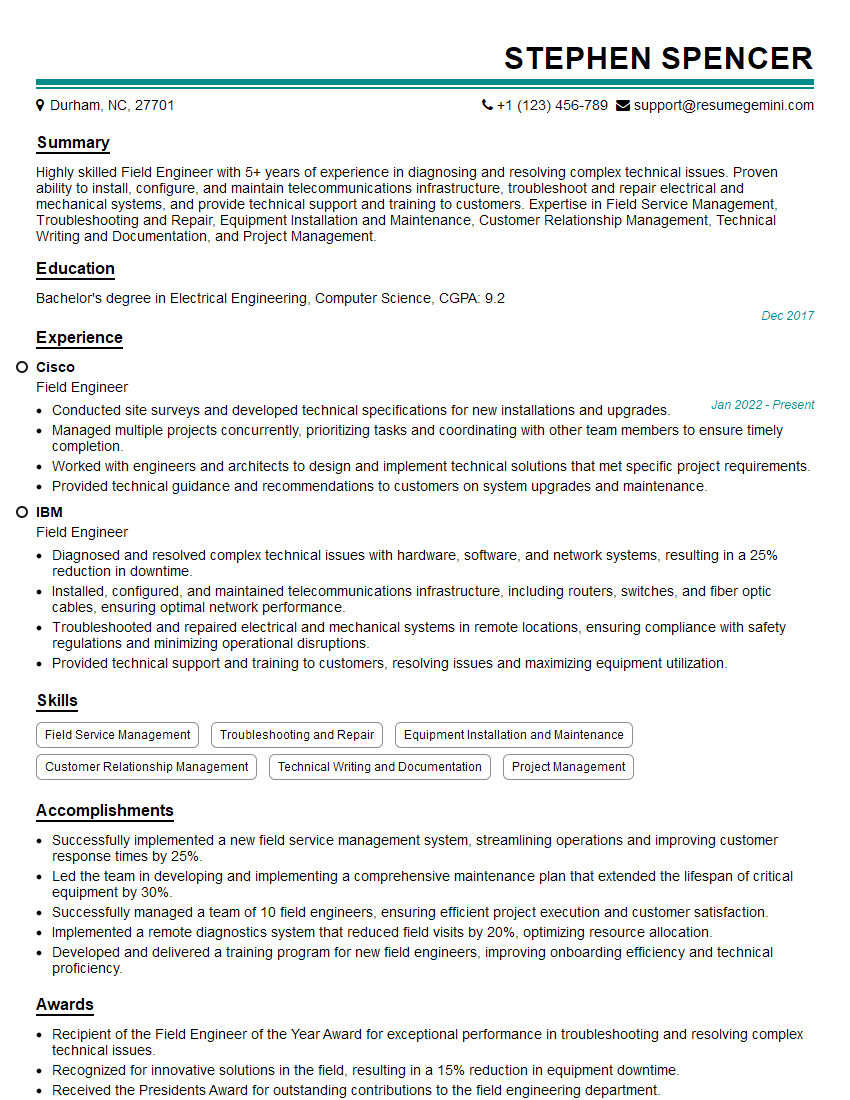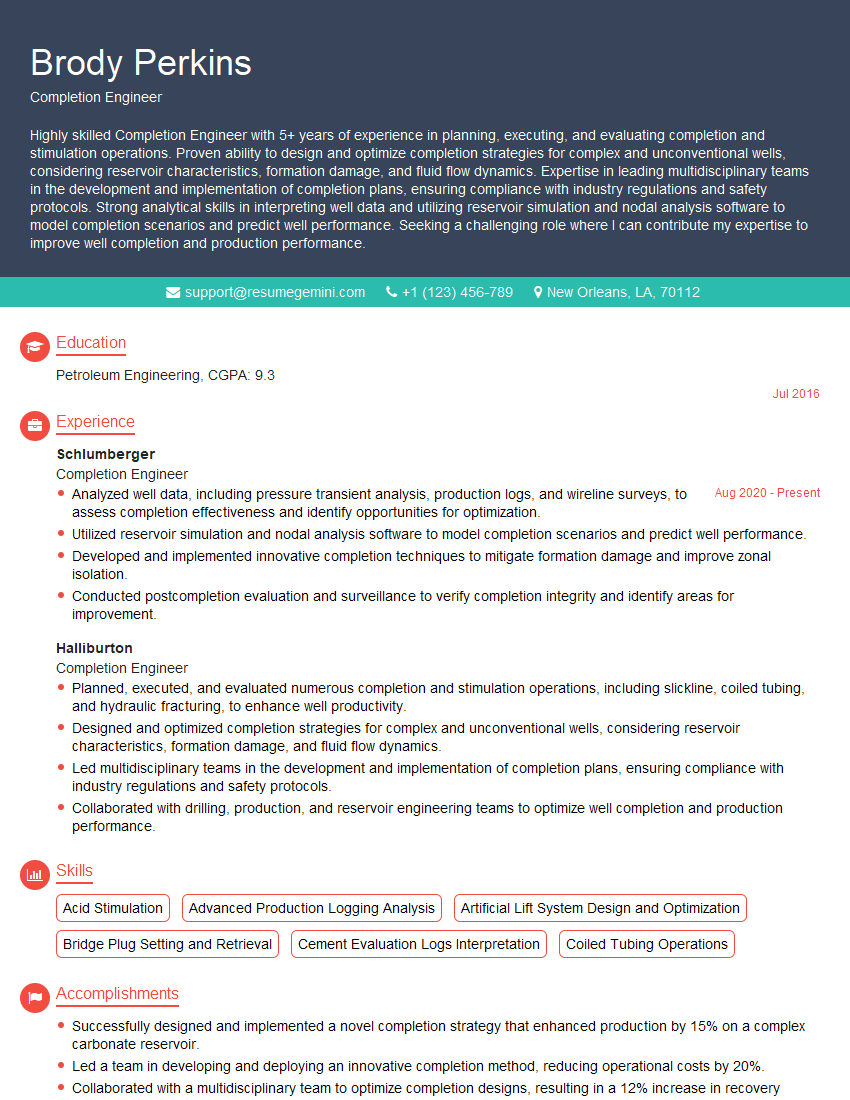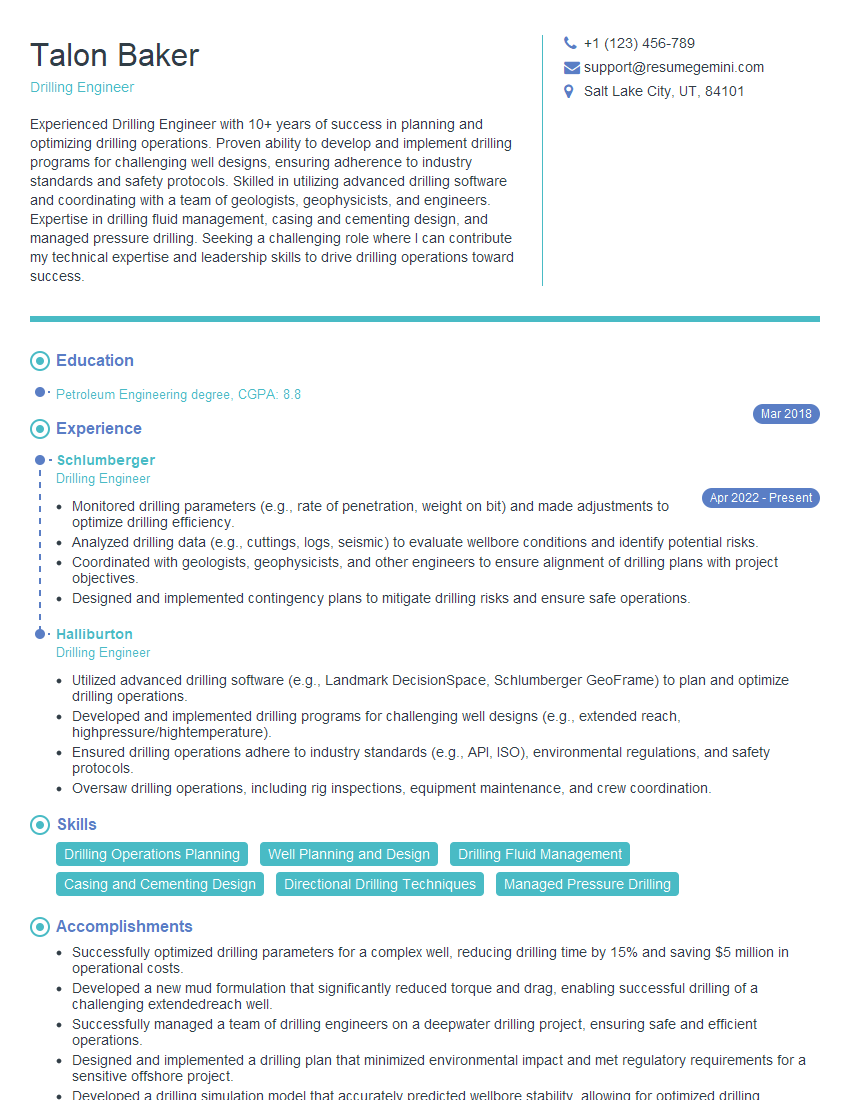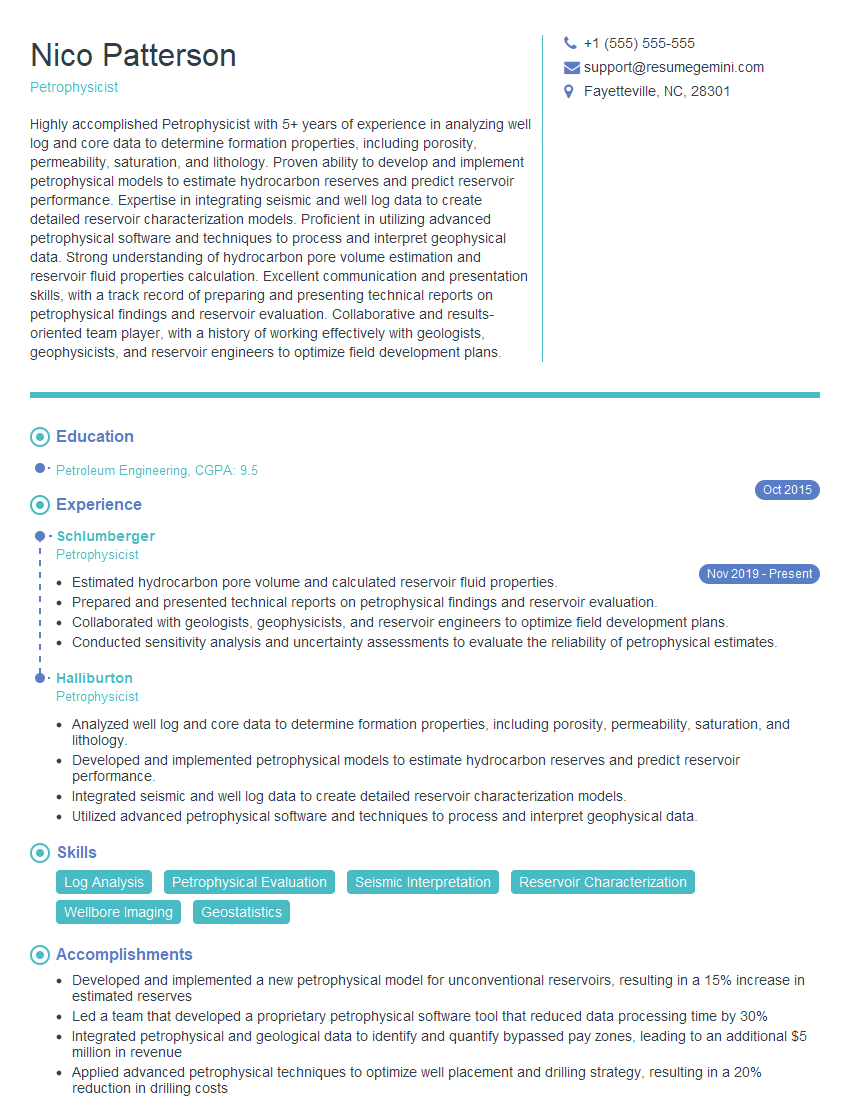Feeling uncertain about what to expect in your upcoming interview? We’ve got you covered! This blog highlights the most important Estimation of Formation Properties interview questions and provides actionable advice to help you stand out as the ideal candidate. Let’s pave the way for your success.
Questions Asked in Estimation of Formation Properties Interview
Q 1. Explain the concept of porosity and its different types.
Porosity is the fraction of void space in a rock formation. Think of it like a sponge – the more holes it has, the higher its porosity. It’s crucial for determining how much oil, gas, or water a reservoir can hold. Porosity is typically expressed as a percentage. There are two main types:
- Total Porosity: This represents the total volume of voids, regardless of whether they are interconnected or not. It’s the total empty space in the rock.
- Effective Porosity: This is the fraction of interconnected pore spaces that contribute to fluid flow. Only interconnected pores are relevant for hydrocarbon production, as fluids can’t move through isolated pores. Imagine a sponge with many tiny, isolated pockets; those wouldn’t contribute to the sponge’s ability to absorb liquid effectively. That’s the difference between total and effective porosity.
Understanding the difference between total and effective porosity is vital for reservoir characterization. A formation might have high total porosity but low effective porosity, rendering it a poor hydrocarbon producer.
Q 2. Describe the various methods for determining formation porosity from well logs.
Formation porosity can be determined from well logs using several methods, most commonly through density, neutron, and sonic logs. Each method exploits different physical properties of the formation:
- Density Log Porosity: This method compares the bulk density of the formation to the density of the rock matrix and the fluid filling the pores. A higher porosity indicates a lower bulk density because the lighter fluid (water, oil, gas) occupies more volume. The formula typically involves matrix density, fluid density, and the measured bulk density from the log.
- Neutron Log Porosity: This method uses a neutron source to bombard the formation. The neutrons slow down (become thermalized) more readily in hydrogen-rich fluids than in the rock matrix. The count of thermal neutrons is inversely proportional to the formation porosity; more thermal neutrons indicate less porosity because fewer hydrogen atoms are present in the fluid-filled pores. This method works best in formations saturated with water, but can be affected by the presence of hydrocarbons.
- Sonic Log Porosity: This method measures the time it takes for a sound wave to travel through the formation. The velocity of sound is faster in a solid rock matrix than in fluids. Therefore, higher porosity translates to lower sound velocities.
It is important to note that each log has its own limitations. For instance, shale volume can significantly affect neutron log readings, whereas lithology variations can influence density and sonic log interpretations. Often, a combination of these logs is used to improve accuracy and account for these limitations, utilizing cross-plots and integrated workflows.
Q 3. How do you calculate water saturation from well logs? Explain the different methods.
Water saturation (Sw) is the fraction of pore volume occupied by water. Several methods use well logs to calculate Sw. The most common is Archie’s equation, but others exist, each with its own advantages and disadvantages.
- Archie’s Equation: This is the most widely used method. It relates water saturation to porosity, resistivity, and formation water resistivity (Rw):
Swn = a*Rw*(Φm/Rt), where:- Sw is water saturation
- n is the cementation exponent (typically 2)
- a is the tortuosity factor (typically 1)
- Rw is formation water resistivity
- Φ is porosity
- m is the cementation exponent (typically 2)
- Rt is true formation resistivity
- Simandoux Equation: This is an extension of Archie’s equation, accounting for the presence of hydrocarbons. It introduces additional parameters to describe the hydrocarbon saturation and its effect on the resistivity.
- Waxman-Smits Equation: This equation is particularly useful in shaly formations where the clay content significantly impacts the resistivity measurements. It takes into account the cation exchange capacity of the clay minerals.
The choice of method depends on the characteristics of the reservoir. For clean sandstones, Archie’s equation often suffices. However, for shaly sands or complex lithologies, more sophisticated equations, such as Waxman-Smits, are necessary to obtain accurate water saturation estimates.
Q 4. What are the limitations of using Archie’s equation for water saturation?
Archie’s equation, while widely used, has several limitations:
- Assumption of clean sands: It assumes a clean sandstone formation with minimal clay content. The presence of clay significantly alters the rock’s electrical properties, leading to inaccurate Sw estimations.
- Constant values for ‘a’ and ‘m’: The tortuosity factor (‘a’) and cementation exponent (‘m’) are assumed to be constant, but they can vary significantly depending on the formation’s geological history and pore structure. Variations in these parameters can lead to significant errors in the calculation of water saturation.
- Accurate Rw determination: Accurate determination of formation water resistivity (Rw) is crucial. Errors in Rw estimation directly affect the calculated Sw.
- Influence of hydrocarbon type: Archie’s equation doesn’t explicitly consider the type of hydrocarbon present (oil or gas), which can affect the resistivity measurements.
Therefore, it’s essential to understand these limitations and consider using alternative equations or techniques when dealing with complex formations or when high accuracy is required. Careful log analysis and geological interpretation are crucial to mitigate these limitations.
Q 5. Explain the concept of permeability and its relationship to porosity.
Permeability is a measure of a rock’s ability to allow fluids to flow through its pore network. It’s expressed in Darcy or milliDarcy. While porosity indicates the storage capacity of a reservoir, permeability indicates its ability to deliver hydrocarbons to the wellbore. A formation can have high porosity but low permeability if the pore spaces are not interconnected, rendering it unproductive.
The relationship between porosity and permeability isn’t always straightforward. A formation with high porosity doesn’t necessarily mean it has high permeability. The pore geometry, pore connectivity, and the presence of cement or clay can significantly affect permeability. Imagine a sponge with large pores that are not connected – it holds a lot of water (high porosity) but water cannot flow through it (low permeability). This illustrates the key difference and independence of the two properties.
Q 6. Describe different methods for estimating permeability from well logs.
Estimating permeability from well logs is challenging because direct measurement is only possible through core analysis. Several indirect methods are available:
- Empirical correlations: These correlations relate permeability to porosity and other log-derived properties. These correlations are often developed based on core data from similar formations. They provide a first-order estimate of permeability, but their accuracy can vary.
- Hydraulic flow units (HFU): This approach groups similar permeability values within a reservoir based on log data, providing a more detailed permeability profile. It helps understand the heterogeneity within the formation.
- Permeability-porosity transforms: These techniques use various log-derived parameters (such as resistivity, sonic velocity) to create empirical relationships with permeability.
- Improved permeability estimation techniques: These incorporate machine learning algorithms to build robust predictive models based on extensive core data and log information.
The best method depends on the quality of available core data and the characteristics of the reservoir. Calibration with core data is crucial to improve the reliability of log-derived permeability estimates.
Q 7. What are the challenges in estimating permeability in low-permeability formations?
Estimating permeability in low-permeability formations presents several challenges:
- Limited fluid flow: Low permeability means that fluid flow is very slow, making it difficult to obtain reliable permeability measurements from well testing.
- Influence of capillary pressure: Capillary forces significantly affect fluid movement in low-permeability formations, and these effects are difficult to model.
- Log resolution limitations: Standard well logs may not have the resolution to adequately characterize the fine-scale heterogeneity found in low-permeability formations.
- Influence of micro-fractures: The presence of micro-fractures can dramatically impact permeability, but these fractures are often too small to be resolved by conventional well logs.
- Data uncertainty: The inherent uncertainties associated with log interpretation are amplified in low-permeability formations due to the inherent difficulties in obtaining accurate measurements.
Advanced logging techniques, such as micro-resistivity imaging and nuclear magnetic resonance (NMR) logging, can provide more detailed information about pore structure and permeability in low-permeability reservoirs. However, even with these advanced techniques, accurate permeability estimation in such formations remains a challenge.
Q 8. Explain the concept of irreducible water saturation.
Irreducible water saturation (Swir) is the fraction of pore space in a reservoir rock that remains filled with water even when the rock is fully saturated with hydrocarbons. Think of it like this: imagine a sponge soaked in water. You can squeeze out a lot of the water, but no matter how hard you squeeze, a tiny bit always clings to the fibers. That remaining water is analogous to irreducible water saturation. It’s held in place by capillary forces and surface tension within the pore spaces.
Swir is crucial in reservoir engineering because it directly impacts the amount of hydrocarbons that can be extracted. A higher Swir means a smaller volume of pore space is available for hydrocarbons, reducing the overall recoverable reserves. It’s determined through laboratory core analysis or estimated from well log data using empirical relationships.
For example, a sandstone reservoir might have an Swir of 20%, meaning 20% of the pore space is always filled with water, leaving 80% for oil or gas. This value varies significantly depending on the rock type, pore geometry, and wettability (whether the rock prefers to be wetted by water or oil).
Q 9. How do you identify hydrocarbons using well logs?
Hydrocarbons are identified in well logs primarily by their effect on resistivity and porosity measurements. Hydrocarbons are non-conductive, so their presence leads to increased formation resistivity compared to water-saturated zones. Conversely, the porosity logs (like neutron and density logs) indicate the total pore volume. By combining these logs, we can detect hydrocarbon-bearing formations.
The process typically involves calculating the water saturation (Sw) using Archie’s equation or its variations. This equation relates resistivity, porosity, water resistivity, and a few formation factors (cementation exponent and saturation exponent). When Sw is significantly less than 1, it indicates the presence of hydrocarbons. Visual inspection of crossplots of resistivity against porosity can also be very helpful in identifying hydrocarbon zones.
For instance, a high resistivity reading combined with high porosity on a neutron log suggests a potentially hydrocarbon-bearing reservoir. However, other factors must be considered like shale volume, to ensure accurate interpretation. Experienced petrophysicists use their knowledge of the specific formation type and geological setting to accurately interpret the results.
Q 10. What are the common types of well logs used in formation evaluation?
Many well logs are employed in formation evaluation, each offering unique information about the subsurface formation. Some common types include:
- Resistivity Logs: Measure the electrical resistance of the formation, indicating the presence of hydrocarbons (high resistivity) or water (low resistivity).
- Porosity Logs: Measure the pore space volume in the formation, including neutron, density, and sonic logs. Neutron logs use neutron interactions, density logs measure bulk density, and sonic logs measure the speed of sound wave propagation through the formation.
- Nuclear Magnetic Resonance (NMR) Logs: Measure the pore size distribution and fluid properties within the formation.
- Gamma Ray Logs: Measure the natural radioactivity of the formation, helping to differentiate between shale (high radioactivity) and sandstone/carbonate (low radioactivity).
- Caliper Logs: Measure the diameter of the borehole, providing information on hole size and formation stability.
The combination of several logs provides a comprehensive understanding of the reservoir rock properties, leading to more accurate estimations of hydrocarbon reserves and reservoir quality.
Q 11. Explain the principle of nuclear magnetic resonance (NMR) logging.
Nuclear Magnetic Resonance (NMR) logging is based on the principle of nuclear magnetism. Hydrogen nuclei (protons) in the formation’s fluids (water and hydrocarbons) possess a magnetic moment. When exposed to a strong magnetic field generated by the logging tool, these protons align themselves with the field. A radio frequency (RF) pulse is then applied, causing the protons to momentarily shift their alignment. Once the pulse ceases, the protons gradually realign with the magnetic field, emitting a signal that is detected by the tool.
The strength and decay rate of this signal are related to the number of hydrogen nuclei present (related to porosity and fluid type) and the pore size distribution. The key is that the relaxation time (the time it takes for the protons to realign) is directly related to the size of the pores they reside in. Larger pores have longer relaxation times, and smaller pores have shorter relaxation times.
Q 12. How does NMR logging help in determining pore size distribution?
NMR logging excels at determining pore size distribution because the relaxation times (T1 and T2) are directly linked to the pore size. Smaller pores restrict the movement of water molecules, leading to faster relaxation times (shorter T2). Larger pores allow for more freedom of movement, resulting in slower relaxation times (longer T2).
The NMR log provides a pore size distribution histogram, showing the volume of pore space associated with different pore sizes. This is invaluable information for reservoir characterization as it helps assess reservoir quality, permeability, and fluid mobility. For example, a formation with a large proportion of large pores is typically more permeable than one dominated by small pores.
The data is processed to create T2 distributions that directly link to pore size ranges. Analyzing this histogram allows the petrophysicist to understand how much pore space falls into different size categories and potentially assess the presence of microporosity and connected porosity, which are crucial to permeability and fluid flow.
Q 13. Explain the concept of formation resistivity and its significance.
Formation resistivity is the ability of a formation to resist the flow of electric current. It’s a crucial parameter in formation evaluation because it’s highly sensitive to the presence and type of fluids within the pore spaces. Water is a conductor, while hydrocarbons are insulators. Therefore, formations saturated with hydrocarbons exhibit much higher resistivity than those saturated with water.
The significance of formation resistivity lies in its use in determining water saturation (Sw) using Archie’s equation or similar empirical relationships. Knowing the water saturation is critical for calculating the hydrocarbon volume in a reservoir, which is essential for reserve estimation and production planning. Resistivity also provides insights into the overall formation quality and the presence of conductive minerals.
Q 14. Describe different methods for estimating formation resistivity.
Several methods are used to estimate formation resistivity. The most common is direct measurement using resistivity logs. These logs employ different tools that send electrical current into the formation and measure the resulting voltage drop. Different types of resistivity logs (e.g., induction, lateral, and micro-resistivity) measure resistivity at different investigation depths and radii, providing information about the formation’s resistivity at various scales.
Another method involves indirect estimation through the use of empirical relationships, like Archie’s equation: Rt = a * Rw * ∅-m * Sw-n. Where:
Rtis the true formation resistivityRwis the resistivity of the formation water∅is the porositySwis the water saturationa,m, andnare formation factors (cementation exponent, saturation exponent).
By knowing the porosity (from density or neutron logs), water resistivity (from other logs or laboratory measurements), and the formation factors (obtained from core analysis or empirical correlations), the formation resistivity can be estimated. This indirect method is essential when direct measurements are unavailable or unreliable.
Q 15. How do you account for borehole effects when interpreting well logs?
Borehole effects significantly impact well log interpretation because the drilling process alters the formation’s natural state. The invaded zone, created by drilling mud filtrate invading the formation, has different properties than the uninvaded zone. This difference leads to inaccurate measurements if not corrected.
We account for borehole effects using several methods. One common technique is using correction charts and equations specific to the logging tool and borehole geometry. These charts provide factors to adjust the measured values, bringing them closer to the true formation properties. For example, the diameter of the borehole and the resistivity of the mud filtrate are crucial parameters in correcting resistivity logs. Another approach involves employing advanced logging tools like those with micro-resistivity devices. These tools measure resistivity closer to the borehole wall, reducing the influence of the invaded zone.
For instance, in a high-porosity sandstone reservoir with a large invaded zone, a standard resistivity log might significantly underestimate the true formation resistivity. Applying a borehole correction, taking into consideration mud filtrate resistivity and borehole diameter, would provide a more realistic estimate. Ignoring these effects can lead to misinterpretations of reservoir quality and potentially flawed hydrocarbon estimations.
Career Expert Tips:
- Ace those interviews! Prepare effectively by reviewing the Top 50 Most Common Interview Questions on ResumeGemini.
- Navigate your job search with confidence! Explore a wide range of Career Tips on ResumeGemini. Learn about common challenges and recommendations to overcome them.
- Craft the perfect resume! Master the Art of Resume Writing with ResumeGemini’s guide. Showcase your unique qualifications and achievements effectively.
- Don’t miss out on holiday savings! Build your dream resume with ResumeGemini’s ATS optimized templates.
Q 16. What is the difference between apparent resistivity and true resistivity?
The difference between apparent resistivity and true resistivity lies in the measurement environment. True resistivity is the inherent electrical resistivity of a formation in its undisturbed state. It’s the property we ideally want to determine, reflecting the formation’s composition and fluid content. Apparent resistivity, on the other hand, is what the logging tool measures. It’s often affected by various factors such as borehole conditions (diameter, mud filtrate invasion), tool geometry, and formation layering.
Imagine you’re trying to measure the resistance of a wire. The true resistivity is the inherent resistance of the wire material. However, if the wire is coated with an insulating layer, the apparent resistivity you measure will be higher, reflecting the combined resistance of the wire and the coating. Similarly, in a wellbore, the invaded zone acts as an ‘insulating layer’ influencing the apparent resistivity.
Correcting apparent resistivity to obtain true resistivity requires careful consideration of these influencing factors. Sophisticated software and specialized algorithms are often used to account for these effects and estimate the true formation resistivity, which is crucial for accurate reservoir evaluation and hydrocarbon saturation calculations.
Q 17. Explain the concept of shale volume and its impact on formation evaluation.
Shale volume (Vsh) represents the proportion of shale in a formation. It’s a crucial parameter in formation evaluation because shale acts as a significant barrier to hydrocarbon flow. High shale volume indicates poor reservoir quality, while low shale volume suggests better reservoir potential.
Shale’s impact stems from its inherent properties: low porosity and permeability, and its typically high water saturation. The presence of shale reduces the effective porosity and permeability available for hydrocarbon storage and flow. This means a high Vsh formation will have lower hydrocarbon saturation for the same total porosity.
Consider two formations with the same total porosity. One has a high shale volume, and the other has a low shale volume. Even if their total porosity values are similar, the formation with lower Vsh will exhibit better reservoir potential due to higher effective porosity and permeability available for hydrocarbon production. Accurate determination of Vsh is vital for reliable reservoir characterization and production forecasting.
Q 18. Describe methods for estimating shale volume from well logs.
Several methods estimate shale volume from well logs. The most common ones utilize the response of different logging tools sensitive to shale content.
- Gamma Ray Log (GR): Shale generally has higher radioactivity than most reservoir rocks. A high GR log reading suggests high shale volume. Simple methods use GR to directly estimate Vsh, while more advanced methods use a linear or non-linear relationship calibrated for the specific formation.
- Neutron Porosity Log (NPHI): While primarily used for porosity determination, the NPHI log can indirectly contribute to shale volume estimation. Shale typically has a higher apparent porosity than other reservoir rocks, so higher-than-expected neutron porosity readings can indicate a higher shale fraction.
- Density Log (RHOB): Similar to the NPHI log, the density log can be used indirectly. Shale has a lower density than many reservoir rocks. Therefore, unexpectedly low density values might imply higher shale volume.
- Combined Methods: The most accurate methods often combine multiple logs. For instance, a common approach uses the GR log along with other logs like NPHI and RHOB to create a more robust and calibrated Vsh estimation.
The specific method chosen depends on the formation type, log quality, and available data. Advanced techniques often incorporate statistical analysis and machine learning algorithms for optimal Vsh estimation.
Q 19. What are the common lithologies encountered in reservoir formations and their impact on log response?
Reservoir formations typically consist of various lithologies, each impacting log responses differently.
- Sandstone: Generally exhibits high porosity and permeability, resulting in low GR readings, high resistivity, and varying responses from density and neutron logs depending on the pore fluid.
- Shale: As discussed, characterized by high GR, low resistivity, and low porosity and permeability.
- Limestone: Typically has moderate to high porosity and permeability, showing moderate to high resistivity and specific responses on density and neutron logs depending on the pore fluid and matrix density.
- Dolomite: Similar to limestone, but often with higher porosity and permeability, leading to different responses on density and neutron logs due to its higher matrix density.
- Coal: Low density, high GR, and very low resistivity, distinctly different from most other lithologies.
Understanding the impact of each lithology on log responses is vital for accurate interpretation. For example, a high resistivity in a sandstone formation indicates the presence of hydrocarbons, while high resistivity in a shale formation can be attributed to its inherent properties. The correct interpretation requires considering the lithology alongside the log data.
Q 20. How do you interpret crossplots of different well logs?
Crossplots of different well logs are invaluable tools for identifying rock types and evaluating reservoir properties. They provide a visual representation of relationships between different log parameters.
For instance, a crossplot of Neutron porosity (NPHI) versus Density porosity (RHOB) can help identify gas zones. Gas exhibits abnormally high NPHI compared to RHOB due to its low electron density. This creates a distinctive trend away from the ‘lithology line’ representing the expected relationship between NPHI and RHOB in formations without gas.
Similarly, a crossplot of GR versus resistivity can delineate shale content. High GR and low resistivity values typically correspond to high shale volume zones. Identifying these trends and clusters helps differentiate between reservoir and non-reservoir intervals, estimate shale volume, and evaluate other formation characteristics.
The interpretation relies on understanding the expected relationships between different log parameters for various lithologies and pore fluids. In practice, crossplots are often combined with other analytical techniques, such as statistical analysis and petrophysical modeling, to provide comprehensive reservoir characterization.
Q 21. Explain the significance of capillary pressure in reservoir characterization.
Capillary pressure is the pressure difference required to displace a non-wetting fluid (typically oil or gas) from the pores of a rock saturated with a wetting fluid (typically water). It’s a crucial concept in reservoir characterization because it dictates the fluid distribution within the reservoir at various depths and pressures.
Understanding capillary pressure is vital for determining hydrocarbon saturation at different depths and estimating the amount of recoverable hydrocarbons. A high capillary pressure indicates that the formation requires a significant pressure difference to displace water and release hydrocarbons. This is commonly associated with lower permeability formations, which may have a higher irreducible water saturation.
Capillary pressure data, often obtained from laboratory core measurements, are used in conjunction with well logs to build reservoir simulation models. These models predict reservoir behavior under various production scenarios and help optimize production strategies. For example, understanding capillary pressure curves allows engineers to better predict the oil-water contact (OWC) and gas-oil contact (GOC) in the reservoir, which are crucial for determining recoverable reserves.
Q 22. Describe the methods for estimating capillary pressure from well logs.
Estimating capillary pressure from well logs relies on indirect methods, as direct measurement isn’t feasible in-situ. We leverage the relationship between capillary pressure (the pressure difference across the interface between two immiscible fluids in a porous medium) and other measurable well log properties. The most common approach involves using the relationship between water saturation (Sw) and the formation’s resistivity (Rt) obtained from logs like the deep resistivity (Rxo) and the shallow resistivity (Rt). This relationship is described by Archie’s equation: Rt = a*Rw/∅^m*Sw^n where a is the tortuosity factor, Rw is the resistivity of the formation water, ∅ is the porosity, m is the cementation exponent, and n is the saturation exponent.
By combining Archie’s equation with capillary pressure curves obtained from core analysis (laboratory measurements), we can estimate the capillary pressure profile in the formation. Several techniques exist, including:
- Saturation Height Method: This approach uses the height of the water column to estimate capillary pressure based on the known relationship between Sw and height. It requires careful consideration of hydrostatic pressure gradients.
- Empirical Correlations: Various empirical correlations relate Sw (from resistivity logs) to capillary pressure, often using specific parameters derived from core data to adjust the correlation for the reservoir’s specific characteristics.
- Numerical Methods: Advanced methods involve numerical inversion techniques that utilize the entire Sw-Pc relationship to estimate capillary pressure profiles with greater accuracy. These often integrate petrophysical models with reservoir simulation tools.
It’s crucial to remember that these indirect methods rely on the accuracy of the input parameters and the validity of the assumed relationships. The reliability of the capillary pressure estimates is thus strongly linked to the quality of both well log and core data, and the careful selection of appropriate empirical correlations or numerical models.
Q 23. How do you integrate well log data with core data for reservoir characterization?
Integrating well log data with core data is crucial for accurate reservoir characterization because well logs provide continuous data along the wellbore, while core data offers detailed, point-specific measurements of rock properties. This integrated approach ensures a more comprehensive understanding of the reservoir than using either data set alone. Here’s a typical workflow:
- Data Calibration: Core data is used to calibrate well log interpretations. This involves comparing core measurements of porosity, permeability, and saturation to the corresponding log values. This step helps to determine appropriate petrophysical models and correction factors for the well logs.
- Cross-Plotting: Core and log data are plotted against each other (e.g., porosity from core vs. porosity from density log) to identify trends and correlations. Deviations highlight potential issues with either the core data, log data, or the chosen log interpretation methods.
- Petrophysical Model Development: The calibrated data is used to develop detailed petrophysical models. These models incorporate the relationships between well log responses and reservoir properties, allowing for the prediction of these properties throughout the reservoir volume.
- Facies Analysis: Combining core-based facies classification with log responses allows for the identification and mapping of different reservoir lithologies and their associated petrophysical properties. This improves reservoir segmentation.
- Reservoir Simulation Input: The integrated data are used to generate high-quality input parameters (porosity, permeability, saturation) for reservoir simulation models. The accuracy of the simulation heavily relies on the quality of this integrated data.
An example would be using core measurements of permeability to calibrate a permeability model based on neutron and density log data. This allows us to estimate permeability throughout the reservoir, even where no core data is available.
Q 24. What are the limitations of well log interpretation?
Well log interpretation, while powerful, has limitations. These stem from the indirect nature of log measurements, borehole conditions, and the inherent assumptions made during interpretation. Some key limitations include:
- Borehole Effects: Factors like mud invasion, borehole rugosity, and wellbore conditions (diameter, casing, etc.) can significantly affect log responses and introduce errors. Corrections are often applied, but these are not always perfect.
- Vertical Resolution: Well logs only measure properties averaged over a certain vertical interval. This ‘smearing’ effect can obscure fine-scale heterogeneities within the formation.
- Limited Horizontal Resolution: Log measurements are primarily sensitive to the properties in a relatively small radius around the borehole. This limits our ability to directly image lateral changes.
- Assumption Dependence: Most log interpretations rely on assumptions such as the validity of Archie’s equation, or the homogeneity of certain properties in a given zone. If the assumptions are incorrect, the interpretations will be erroneous.
- Data Quality Issues: Problems during data acquisition (e.g., bad tool response, environmental noise) can lead to unreliable log data. Data quality control is paramount.
- Ambiguity: Sometimes, multiple interpretations may be equally consistent with the observed log data, making it challenging to pinpoint the exact reservoir properties.
Understanding these limitations is crucial for developing robust and realistic reservoir models. Always consider the potential sources of uncertainty and incorporate error analysis into the interpretation process.
Q 25. How can you use formation evaluation data to help in reservoir simulation?
Formation evaluation data is indispensable for reservoir simulation. It provides the essential input parameters that define the reservoir’s geometry, petrophysical properties, and fluid content. Specifically:
- Reservoir Geometry: Well logs help to define the reservoir boundaries, thickness, and shape. This information is used to create the geological model for the simulator.
- Petrophysical Properties: Porosity, permeability, water saturation, and other petrophysical properties are critical inputs. These are estimated from well log analysis (and often calibrated with core data), which define the reservoir’s fluid flow capacity.
- Fluid Properties: Formation water salinity, oil and gas properties (density, viscosity, composition) are crucial for accurate fluid flow modeling. These parameters are often inferred from other sources or dedicated well tests, but well logs might offer helpful constraints.
- Facies Modeling: Formation evaluation helps classify different rock types and their distributions. These facies models are used to create a more realistic reservoir model in the simulation, reflecting the spatial variability of reservoir properties.
The quality of the formation evaluation data directly impacts the accuracy and reliability of reservoir simulation results. Inaccurate or incomplete data can lead to significant errors in predicting production performance and reservoir management strategies.
For example, incorrectly estimating permeability can lead to over- or under-estimation of production rates and ultimate recovery.
Q 26. Explain the concept of uncertainty in formation evaluation and how to quantify it.
Uncertainty is inherent in formation evaluation because the measurements are indirect, and the models used are simplifications of complex processes. Quantifying this uncertainty is crucial for making informed decisions. Methods include:
- Propagation of Errors: This method involves quantifying the uncertainties in individual log measurements and propagating them through the petrophysical models to determine the uncertainty in the derived parameters (e.g., porosity, permeability). Statistical tools such as Monte Carlo simulations are frequently employed.
- Sensitivity Analysis: This examines how sensitive the estimated reservoir properties are to variations in input parameters. This helps identify the critical factors that contribute the most to uncertainty.
- Multiple Interpretations: Generating multiple interpretations of the same log data, using different petrophysical models or assumptions, allows for the assessment of the range of plausible reservoir properties.
- Comparison with Other Data: Comparing well log interpretations with data from other sources, such as core analysis, production testing, or seismic surveys, can help constrain the uncertainty and identify discrepancies.
- Bayesian Inference: Bayesian methods can integrate prior knowledge and expert judgment to update the uncertainty in estimated properties based on new information.
Visualizing uncertainty, for example, through probability distributions or confidence intervals, is essential for transparent communication and better decision making. Without a proper understanding of uncertainty, one might overestimate the certainty of formation evaluation results.
Q 27. Describe your experience using formation evaluation software.
Throughout my career, I’ve extensively used various formation evaluation software packages, including (mention specific software names like Petrel, IHS Kingdom, Schlumberger’s Petrel, etc.). My experience encompasses data processing, quality control, log interpretation, petrophysical modeling, and integration with other geoscience data. I am proficient in:
- Log Data Processing: Cleaning, editing, and correcting well log data to ensure accuracy.
- Log Interpretation Techniques: Applying various interpretation techniques to derive key reservoir properties, including porosity, permeability, water saturation, and lithology. I am familiar with both deterministic and statistical approaches.
- Petrophysical Modeling: Developing and applying sophisticated petrophysical models using the software’s capabilities to quantify uncertainties and enhance the reliability of interpretations.
- Data Integration: Integrating well log data with core data, seismic data, and other relevant datasets for comprehensive reservoir characterization. This involves creating consistent geological models within the software.
- Report Generation: Generating comprehensive reports and presentations, including maps, cross-sections, and other visualizations to communicate findings effectively.
I’ve utilized these software tools in numerous projects, from appraisal studies to full-field reservoir development planning, contributing significantly to the success of these endeavors. A specific example would be (briefly describe a project where you used this software and highlight a positive outcome).
Q 28. How do you stay updated on the latest advancements in formation evaluation techniques?
Keeping abreast of advancements in formation evaluation requires a multi-faceted approach:
- Professional Societies and Conferences: Active participation in organizations like the Society of Petroleum Engineers (SPE) and attending relevant conferences allows me to learn about the latest research and technological innovations.
- Industry Publications and Journals: Regularly reviewing technical publications, including SPE journals and industry magazines, helps stay informed about new methodologies and applications.
- Online Resources and Webinars: Utilizing online platforms and attending webinars provides access to a wide range of information and expert insights.
- Software Updates and Training: Staying up-to-date with software updates and participating in training programs offered by software vendors ensures I am proficient in the latest tools and techniques.
- Collaboration and Networking: Engaging in discussions with colleagues and experts in the field, attending workshops, and participating in collaborative projects allows for sharing of knowledge and experience.
Continuous learning is essential in this rapidly evolving field, and I am committed to staying at the forefront of advancements in formation evaluation techniques.
Key Topics to Learn for Estimation of Formation Properties Interview
- Porosity and Permeability: Understanding the theoretical concepts of porosity and permeability, including different types and their measurement techniques. Practical application: Analyzing well log data to estimate reservoir properties.
- Capillary Pressure: Grasping the principles of capillary pressure and its impact on fluid distribution in porous media. Practical application: Predicting hydrocarbon saturation and evaluating reservoir connectivity.
- Fluid Saturation: Mastering the methods for estimating water, oil, and gas saturations, including Archie’s equation and its limitations. Practical application: Determining the hydrocarbon reserves in a reservoir.
- Rock Compressibility: Understanding the concept of rock compressibility and its influence on reservoir behavior. Practical application: Modeling reservoir compaction and subsidence.
- Formation Evaluation Techniques: Familiarize yourself with various techniques like wireline logging (e.g., density, neutron, sonic logs), core analysis, and pressure testing. Practical application: Integrating data from multiple sources for a comprehensive reservoir characterization.
- Uncertainty Analysis: Understanding how to quantify uncertainty in formation property estimations and its implications for decision-making. Practical application: Assessing the risk associated with reservoir development plans.
- Special Core Analysis (SCAL): Gaining knowledge of advanced core analysis techniques to determine crucial reservoir parameters not easily obtained from conventional methods. Practical application: Improving the accuracy of reservoir simulations.
Next Steps
Mastering the estimation of formation properties is crucial for career advancement in the petroleum engineering and geoscience fields. A strong understanding of these concepts opens doors to exciting roles with greater responsibility and higher earning potential. To significantly boost your job prospects, it’s vital to present your skills effectively through a well-crafted, ATS-friendly resume. ResumeGemini is a trusted resource to help you build a professional and impactful resume that highlights your expertise. They provide examples of resumes tailored to the Estimation of Formation Properties field, ensuring your application stands out. Invest time in creating a compelling resume – it’s your first impression and a key to unlocking your career potential.
Explore more articles
Users Rating of Our Blogs
Share Your Experience
We value your feedback! Please rate our content and share your thoughts (optional).
What Readers Say About Our Blog
Take a look at this stunning 2-bedroom apartment perfectly situated NYC’s coveted Hudson Yards!
https://bit.ly/Lovely2BedsApartmentHudsonYards
Live Rent Free!
https://bit.ly/LiveRentFREE
Interesting Article, I liked the depth of knowledge you’ve shared.
Helpful, thanks for sharing.
Hi, I represent a social media marketing agency and liked your blog
Hi, I represent an SEO company that specialises in getting you AI citations and higher rankings on Google. I’d like to offer you a 100% free SEO audit for your website. Would you be interested?








